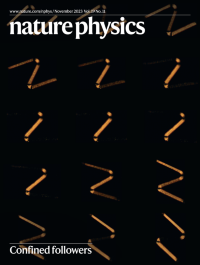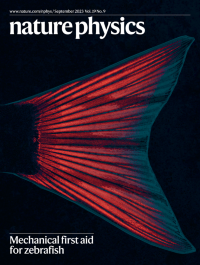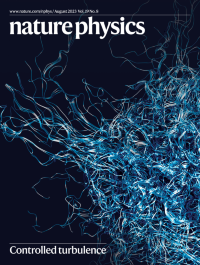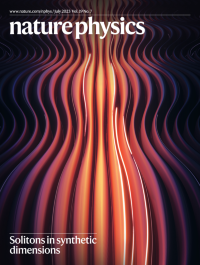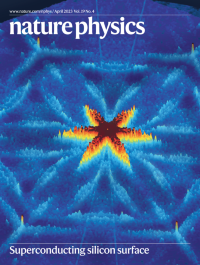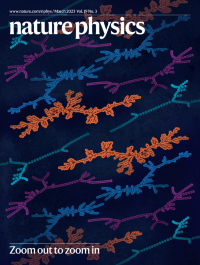Volume 19
-
No. 12 December 2023
Wrinkling suppression in the cell nucleusThe wrinkling of the membrane that contains the cell nucleus as it develops is associated with ageing and disease. Jonathan Jackson and colleagues show that this nuclear wrinkling in the development of fruit fly eggs can be manipulated through osmotic shocks and microtubule inhibition. Indeed, wrinkling can even be reversed, allowing tunable control over the mechanical properties of the membrane.
See Jackson et al.
-
No. 11 November 2023
Confined followersThe polarization field in a ferroelectric nematic liquid crystal can be reoriented with an external electric field. Now, Federico Caimi and co-workers show that when such a liquid crystal is confined in a microchannel and subjected to an electric field, its polarization field aligns with the channel because of a superscreening effect.
See Caimi et al. and Mertelj
-
No. 10 October 2023
Qubit triplets get entangledThe generation of entanglement in quantum computers stems from the native interactions between qubits, which are usually restricted to the pairwise limit. A method to control three- and four-body interactions has now been demonstrated with trapped ions.
See Katz et al. and Research Briefing
-
No. 9 September 2023
Mechanical first aid for zebrafishIt is known that mechanical waves play a role in collective motion of cells, including during the healing of wounds. Marco De Leon and collaborators now show that these waves can help an amputated zebrafish know where its fin was cut off, and that this can aid regeneration.
See De Leon et al. and Matsubayashi
-
No. 8 August 2023
Controlled turbulenceTurbulence is generated using vortex rings as building blocks in a quiescent environment.
See Matsuzawa et al. and Research Briefing
-
No. 7 July 2023
Solitons in synthetic dimensionsSynthetic dimensions can introduce band properties without a periodic structure in real space, but they have largely been studied in linear systems. Now, Nicolas Englebert and collaborators present a study using an optical resonator that shows nonlinear soliton states in synthetic frequency space. This will allow the manipulation of dissipative cavity solitons with potential applications in optical frequency comb generation and nonlinear topological photonics.
See Englebert et al.
-
No. 6 June 2023
Interference on the tipUltrafast electron–photon spectroscopy commonly requires a driving laser. Now, a compact solution to spectral interferometry inside an electron microscope that does not require a laser has been developed. It relies on an inverse approach based on cathodoluminescence spectroscopy.
See Taleb et al. and Kealhofer
-
No. 5 May 2023
Ice expulsionIcephobic surfaces can have many applications in engineering, where they are helpful for increasing safety and sustainability among other things. Poulikakos and co-workers report a study of the behaviour of supercooled droplets freezing on superhydrophobic surfaces and provide insights into ice-repellency mechanisms.
See Lambley et al. and Boreyko
-
No. 4 April 2023
Superconducting silicon surfaceAdatoms on the surface of silicon can create two-dimensional superconductivity, but the order parameter symmetry is currently not known. Now, scanning tunnelling spectroscopy measurements suggest it could be a d-wave state that is topological and hence would host chiral edge modes.
See Ming et al.
-
No. 3 March 2023
Zoom out to zoom inThe renormalization group method is routinely employed to study critical behaviour in many areas of physics, especially those that can be described by field theories. Now, a framework based on such a description of information diffusion extends renormalization group methods to the study of complex networks.
See Villegas et al. and Klemm
-
No. 2 February 2023
Homogeneous transitionThe intermediate states in photo-excited phase transitions are expected to be inhomogeneous. In this work, a spatially resolved ultrafast X-ray imaging technique shows that the early part of the metal–insulator transition in VO2 is homogeneous and that the inhomogeneity only develops after a few hundred femtoseconds.
See Johnson et al.
-
No. 1 January 2023
Another level for quantum logicWhen algorithms are run on a computer, they are broken down into logical operations that are implemented by the hardware. Ji Chu and co-workers have demonstrated a quantum logical AND gate by utilizing a third level in their qubits, and this could substantially improve the efficiency of near-term quantum computers.
See Chu et al. and Jiang


